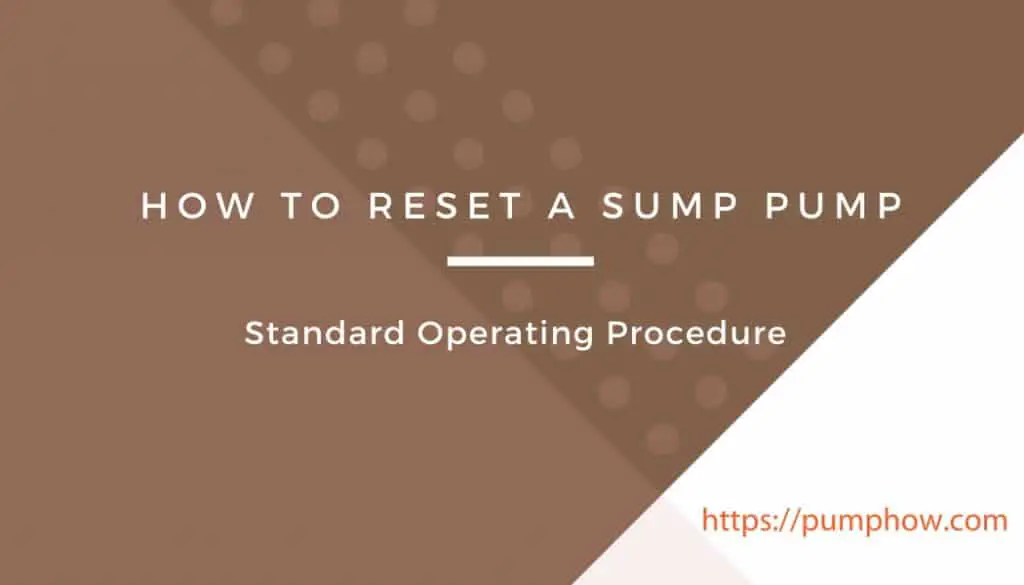A sump system pumps groundwater into the drainage system of a home or completely outside to prevent the accumulation of water in the basement. More than one reason may cause hindrance to this typical function. When none of the causes seem obvious but your sump pump isn’t working quite the expected way, maybe you should reset the sump pump.
Sometimes, the “reset” action proves to be immensely useful, especially when you’re aware of an upcoming disaster, and the pump keeps malfunctioning without any obvious sign of failure.
Unlike sump pump installation or replacement, this particular job doesn’t involve a lot of steps, but you still have a few points to keep in mind.
In this article, we’ll let you know everything on the matter – the right way to reset a sump pump (both manually and automatically), things to do when there’s no “reset” button, and the occasions you shouldn’t adopt this technique.

Standard Procedure To Reset A Sump Pump
You can’t do it without taking the pump out of its place. It means you need to spend more than an hour. So, do it on the weekend or any day when you’re free.
Kill the Power
Some people don’t want to disconnect the pump from its power source. The practice isn’t recommended because getting an electrical shock is one of the last things you want on earth.
Shut off the power at your circuit breaker and disconnect the pump’s power cord. Try to keep safety gear close to your location because some of the problems that your pump might be having can be electrical in nature.
Remove Your Pump
If you’ve put a basin cover to protect it from dirt and other unwanted materials, it’s time to remove the cover and take the sump pump out.
Don’t forget to work on the drainage line. Disconnect the pipes carefully; so you don’t have to bend or damage the union connectors and the pipes.
Use an old tarp or towel to place your pump and the check valve on. The pump or its parts can be dirty and damp, and you don’t want to have your floor covered with such wastes.
Remove Clogging and Debris
If you haven’t done any maintenance in a while, chances are the pit’s bottom may collect small pebbles, grime, dirt, and debris. Even mud isn’t a surprise. Since you have the pit free of the pump, clean it thoroughly.
Check the pit’s exterior because there might be leaks or rust. Treat the surface properly. Some sump systems use filters. If yours has one, clean it. Sometimes, small rocks may find their way inside the body of the pump and cause blockage to the motor which may stall and show signs of failure. Remove them too.
The discharge pipe and drain lines should also be brought into consideration. It’s important for the pump to have these components free of clogs or debris. A faulty discharge system is much like a serious barrier to the pump’s regular functionality as well as its lifespan.
Reconnect the Pump and Its Parts
Can you remember which parts you’ve disconnected or removed from the setup? It’s time to put all of those back in their places. Check your pump’s manual if confusions arise. If you’ve lost it, read our detailed guide to cleaning a sump pump.
Check to see how the float switch works. If it’s able to rise and/or fall just as the sump’s water level does, the switch is okay. Remember you should avoid mistakes by all means while reattaching the different parts.
The above steps may not seem like some quick tasks, and you may not want to do it once a while. But that’s how you can complete it without doubts. There’re much quicker ways, though.
Use the Reset Button
Some models feature a reset button that can be employed to cycle the power so that the motor can be restarted. Don’t just jump onto an advanced procedure before trying this one.
- Locate the “reset” button inside your pump.
- Press and hold it for 5 seconds.
- Release the button to see if the pump gets back to its regular state.
Sometimes, the pump may not work right after the first “reset” attempt. You can try this one more time. If it fails to work this time too, you should prepare for inspecting the whole system because there might be serious issues to cause this failure.
Manual Way To Reset The Sump Pump
Not all sump systems include a “reset” button, but that’s not an end to your efforts. You need to go manual this time.
- Find out where the circuit breaker is.
- Turn it off to disconnect the electrical current to the system.
- Then, turn it on again and wait for the switch to reset itself.
Don’t do this without caution. You’ll be touching things that are simply too dangerous without eyes open for danger.
These actions take just a couple of minutes and often help solve most problems. However, they don’t help much when it comes to mechanical concerns. Thus, the “standard” procedure is the most appropriate way.
When NOT to Reset A Sump Pump
Despite having the right reason, you shouldn’t reset the pump if you see or have any of the following things.
- Smoke coming out of the pump
- Debris or waste matters sticking to the inside or outside portion of the pump too badly
- Loud bangs or other noises as the motor starts or stops
- Broken or damaged discharge pipe/drain line
- Sparkling or exposed electrical wiring
Don’t just finish the “reset” when you’ve one or more of the above issues unattended. Fix them and then proceed to avoid greater risks.
Before we finish, we need to talk about a couple of situations – whether or not you should reset during a flood or after an incident of power failure.
Seeing that your pump isn’t working at its peak, you may intend to reset it. Well, you can, but the wiring must be checked for damages. Don’t stay in contact with water when you’re about to turn your pump on.
Both power surges and outages are critical to a sump pump’s operation and health. During a natural calamity like a storm, power may go out or the breaker at your home may surge. Either way, the electrical system may get fried. Test the power source and then the pump before attempting to reset it.
While resetting your backup pump, you need to reset the particular electrical circuit it relies on. Check its wiring. Power outage may affect the battery as well. So, check it too. Thus, resetting a sump pump may bring the result you want.
We didn’t miss any point, did we? Don’t hesitate to inform us if you’ve any queries regarding how to reset a sump pump.







